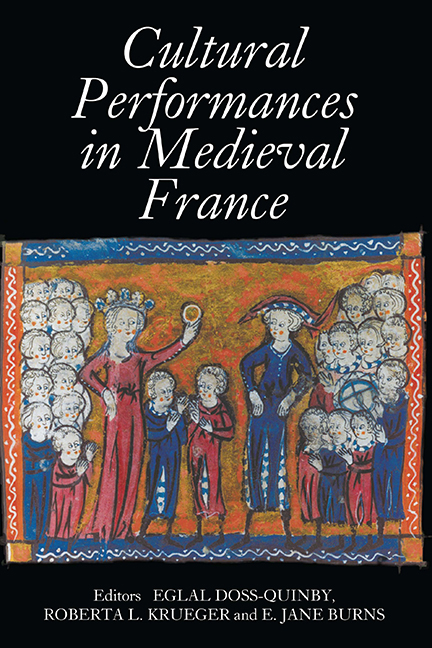Book contents
- Frontmatter
- Contents
- List of Illustrations
- Contributors
- Introduction
- Nancy Freeman Regalado, Curriculum Vitae
- PART I POETIC AND MUSICAL PERFORMANCES
- PART II PERFORMING SEXUAL AND SOCIAL IDENTITIES
- PART III DEVOTIONAL PRACTICE AND TEXTUAL PERFORMANCE
- PART IV PERSUASIVE PERFORMANCES
- Dramatic Troubles of Ecclesia: Gendered Performances of the Divided Church
- Preaching the Sins of the Ladies: Nicole Bozon's “Char d'Orgueil”
- Making Names, Breaking Lives: Women and Injurious Language at the Court of Isabeau of Bavaria and Charles VI
- Performing the Nation: The Play Performed at the Great Feast in Christine de Pizan's Biography of Charles V
- PART V RE–ENACTMENTS AND LEGACIES
- Tabula Gratulatoria
- Tabula Gratulatoria
Dramatic Troubles of Ecclesia: Gendered Performances of the Divided Church
from PART IV - PERSUASIVE PERFORMANCES
Published online by Cambridge University Press: 24 October 2017
- Frontmatter
- Contents
- List of Illustrations
- Contributors
- Introduction
- Nancy Freeman Regalado, Curriculum Vitae
- PART I POETIC AND MUSICAL PERFORMANCES
- PART II PERFORMING SEXUAL AND SOCIAL IDENTITIES
- PART III DEVOTIONAL PRACTICE AND TEXTUAL PERFORMANCE
- PART IV PERSUASIVE PERFORMANCES
- Dramatic Troubles of Ecclesia: Gendered Performances of the Divided Church
- Preaching the Sins of the Ladies: Nicole Bozon's “Char d'Orgueil”
- Making Names, Breaking Lives: Women and Injurious Language at the Court of Isabeau of Bavaria and Charles VI
- Performing the Nation: The Play Performed at the Great Feast in Christine de Pizan's Biography of Charles V
- PART V RE–ENACTMENTS AND LEGACIES
- Tabula Gratulatoria
- Tabula Gratulatoria
Summary
The relationship between the Church and medieval theater was fruitful and complex but it was also contested. Was the medieval Church a facilitator of, or an impediment to, the development of the theatrical form? How, for example, can one define the relationship between the dramatic elements of the liturgy and religious theater? Long ago Karl Young studied the drama of the medieval Church and its relation to the liturgy and posited rather rigid boundaries between the two. For him, any text that does not clearly indicate that human actors impersonate or perform specific characters is not a play. But as Carol Symes has shown in an important study of early medieval theater in France, our modern notions of what constitutes a text meant for performance are inadequate when it comes to the actual written documents and their manuscript context. The “arbiters of genre” Symes skewers want to see watertight categories of plays and non-plays in medieval culture; Symes, by contrast, sees fluid boundaries between a variety of performative texts. Indeed the drama of the medieval Church does not necessarily play itself out on a stage. Symes's study encourages us to rethink definitions of medieval theatricality and the different ways in which the medieval period approached the idea of performance.
For medieval writers there were many ways to stage performances without any explicitly theatrical accoutrements: allegorical psychomachias or interactive dream visions are just two examples of dramas that lose none of their vividness by not being actually performed by human actors. In this essay I propose to look at the notion of performance and its relationship to the medieval Church from a slightly different angle. Here the spotlight will not shine on the question of how the Church influenced the development of medieval theater but on the Church as “actress”: the star performer of my contribution to this volume is Ecclesia herself. My focus will be on the Church shown as suffering from one particular ill: one of the many schisms that again and again tore up her holy body over many centuries. We will see that Ecclesia's troubles are staged in a variety of texts and contexts: sacred and secular poetry, dream visions, and complaints cast in judicial language. In each case we witness a dramatization of a political crisis, a kind of allegorical drama, starring the Church as a complex female personification.
- Type
- Chapter
- Information
- Cultural Performances in Medieval FranceEssays in Honor of Nancy Freeman Regalado, pp. 181 - 194Publisher: Boydell & BrewerPrint publication year: 2007



